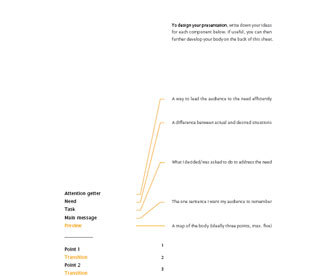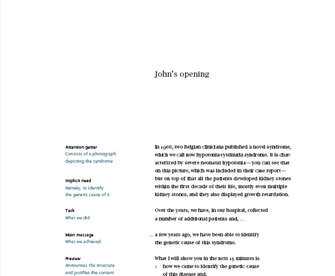Like scientific papers, oral presentations at a conference or internal seminar are for sharing your research work with other scientists. They, too, must convince the audience that the research presented is important, valid, and relevant to them. To this end, oral presentations — like papers — must emphasize both the motivation for the work and the outcome of it, and they must present just enough evidence to establish the validity of this outcome. Also like papers, they must aim to inform, not impress.
In contrast, presentations differ from papers in at least three ways: They are more localized in space and time, they impose a sequence and rhythm to the audience, and they normally include some level of interaction. These three differences affect the selection of a presentation's content.
Unless they are recorded or broadcast, presentations have a more clearly defined audience than papers: They address "the people in the room," here and now. The audience might still be diverse, but less so than for papers. Papers can be forwarded in unpredictable ways and may be read many years from now, so they should be lasting and largely self-contained. In contrast, presentations can have more specific purposes. For example, a presentation at a conference normally aims to present recent advances, whereas a presentation at a Ph.D. symposium aims to inform other Ph.D. students (in other fields) of one student's line of research.
Finally, presentations normally include interaction in the form of questions and answers. This is a great opportunity to provide whatever additional information the audience desires. For fear of omitting something important, most speakers try to say too much in their presentations. A better approach is to be selective in the presentation itself and to allow enough time for questions and answers and, of course, to prepare well by anticipating the questions the audience might have.
As a consequence, and even more strongly than papers, presentations can usefully break the chronology typically used for reporting research. Instead of presenting everything that was done in the order in which it was done, a presentation should focus on getting a main message across in theorem-proof fashion — that is, by stating this message early and then presenting evidence to support it. Identifying this main message early in the preparation process is the key to being selective in your presentation. For example, when reporting on materials and methods, include only those details you think will help convince the audience of your main message — usually little, and sometimes nothing at all.
The opening
- The context as such is best replaced by an attention getter, which is a way to both get everyone's attention fast and link the topic with what the audience already knows (this link provides a more audience-specific form of context).
- The object of the document is here best called the preview because it outlines the body of the presentation. Still, the aim of this element is unchanged — namely, preparing the audience for the structure of the body.
- The opening of a presentation can best state the presentation's main message, just before the preview. The main message is the one sentence you want your audience to remember, if they remember only one. It is your main conclusion, perhaps stated in slightly less technical detail than at the end of your presentation.
In other words, include the following five items in your opening: attention getter, need, task, main message, and preview.



















